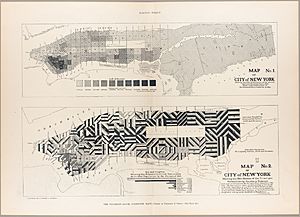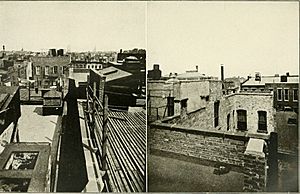New York State Tenement House Act facts for kids
The New York State Tenement House Act of 1901 was an important law passed in New York State. It was part of a time called the Progressive Era, when people worked to fix many problems in society. This law was one of the first to stop the building of dark, unhealthy apartment buildings called tenements. The law made sure new buildings had windows facing outside in every room. They also needed open courtyards, good air systems, indoor toilets, and ways to stay safe from fires.
Early Housing Laws in New York
This wasn't the first time New York State tried to improve housing. Before 1901, there were other laws to make tenements safer and healthier.
First Tenement House Act (1867)
The very first law, passed in 1867, said that every apartment needed fire escapes. It also required each room to have a window.
Second Tenement House Act (1879)
The Second Tenement House Act, from 1879, was called the "Old Law." It fixed a problem from the first law. It said that windows had to face fresh air and light, not just a dark hallway inside the building. In 1887, another change required toilets to be inside the building.
Why the "Old Law" Failed
Even with these changes, the "Old Law" didn't work perfectly. The air shafts built to meet the law's rules often became dirty. They filled with trash, dirty water, and waste. This made them unhealthy instead of helpful. These problems showed why a new, stronger law was needed. This led to the 1901 "New Law," which required courtyards for better air and trash removal.
Why People Wanted Housing Reform
Before these laws, many housing improvements came from philanthropists. These were people or groups who gave money and time to help others. The series of housing laws showed a belief from the Progressive Era. People thought that cleaner cities would lead to better citizens.
Jacob Riis and His Work
Jacob Riis was a famous journalist who wrote about the problems in tenements. In 1890, he published a very important book called How the Other Half Lives: Studies Among the Tenements of New York. Riis showed how bad living conditions were for many people. He believed that the reform movement grew because people feared diseases spreading from crowded areas.
Disease and Public Health
There was a fear of diseases like smallpox, which was very contagious. Diseases like cholera and tuberculosis had already been common in the Lower East Side of New York. This area was a main hub for immigrant families. Riis thought that the new laws helped both those who cared about public health and those who worried about the city's workers.
The Tenement-House Exhibit of 1899
The movement for reform became very strong with the Tenement-House Exhibit of 1899. This big exhibit was held in a fancy building in New York City. Lawrence Veiller helped organize it. The exhibit showed many urban problems, not just building design. It included ideas for bathhouses and parks. This pushed reform beyond just buildings and into bigger ideas about urban planning. After the exhibit, a detailed report was sent to the New York State Commission. This report directly led to the writing of the 1901 "New Law."
How Buildings Changed
The 1901 "New Law" also brought changes in how buildings looked. This was around the same time that Beaux-Arts architecture became popular.
Old vs. New Building Styles
Before the "New Law," tenements often had interesting sandstone faces, gargoyles, and fancy terracotta designs. But with the "New Law," buildings started to look more classical and grand. This was part of the Parisian style that was popular worldwide.
Space and Design
The "New Law" required courtyards that took up more space than the old air shafts. Because of this, new tenements were often built on several lots or on corner lots. This helped save space for apartments, which were how owners made money.
If you walk down a street in the Lower East Side or East Village today, you can see these changes. You might see five-story buildings from before 1879 that are very plain. Then you might see six-story "old law" buildings from before 1901 that are more decorated. Finally, on the corners, you'll often see the larger, grander "New Law Tenements," which are always at least six stories tall.



